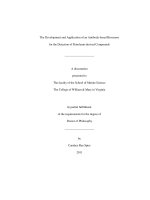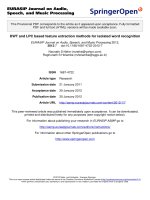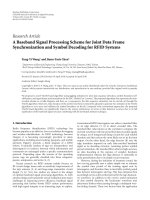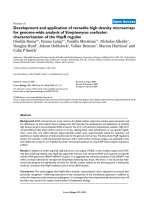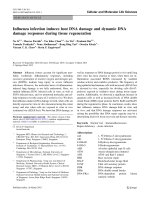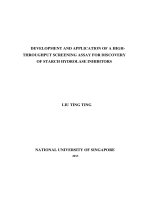Summary of PhD thesis: Development and application of signal processing methods for crack diagnosis of bar structures
Bạn đang xem bản rút gọn của tài liệu. Xem và tải ngay bản đầy đủ của tài liệu tại đây (1.19 MB, 37 trang )
VIETNAM ACADEMY OF SCIENCE AND TECHNOLOGY
GRADUATE UNIVERSITY OF SCIENCE AND TECHNOLOGY
------o0o------
NGUYEN VAN QUANG
DEVELOPMENT AND APPLICATION OF SIGNAL
PROCESSING METHODS FOR CRACK DIAGNOSIS OF
BAR STRUCTURES
Major:
Engineering Mechanics
Code:
9520101
SUMMARY OF PhD THESIS
Hanoi – 2018
The thesis has been completed at:
Vietnam Academy of Science and Technology
Graduate University of Science and Technology
Supervisor: Assoc. Prof. Dr. Nguyen Viet Khoa
Reviewer 1: Prof. Dr. Hoang Xuan Luong
Reviewer 2: Assoc. Prof. Dr. Luong Xuan Binh
Reviewer 3: Assoc. Prof. Dr. Nguyen Phong Dien
Thesis is defended before the State level Thesis Assessment
Council held at: Graduate University of Science and
Technology - Vietnam Academy of Science and Technology.
At ………... on ……………………………………………..
Hardcopy of the thesis can be found at:
+ Library of Graduate University of Science and Technology
+ National Library of Vietnam
List of the Author’s publications
1. Khoa Viet Nguyen, Quang Van Nguyen. Time-frequency
spectrum method for monitoring the sudden crack of a column
structure occurred in earthquake shaking duration. Proceeding
of the International Symposium Mechanics and Control 2011,
p. 158-172.
2. Khoa Viet Nguyen, Quang Van Nguyen. Wavelet based
technique for detection of a sudden crack of a beam-like bridge
during earthquake excitation. International Conference on
Engineering Mechanics and Automation ICEMA August 2012,
Hanoi, Vietnam, p. 87-95.
3. Nguyễn Việt Khoa, Nguyễn Văn Quang, Trần Thanh Hải,
Cao Văn Mai, Đào Như Mai. Giám sát vết nứt thở của dầm
bằng phương pháp phân tích wavelet: nghiên cứu lý thuyết và
thực nghiệm. Hội nghị Cơ học toàn quốc lần thứ 9, 2012, p.
539-548.
4. Khoa Viet Nguyen, Hai Thanh Tran, Mai Van Cao, Quang
Van Nguyen, Mai Nhu Dao. Experimental study for monitoring
a sudden crack of beam under ground excitation. Hội nghị Cơ
họ V r n i n ng oàn uốc lần thứ 11, 2013, p. 605-614.
5. Khoa Viet Nguyen, Quang Van Nguyen. Element stiffness
index distribution method for multi-cracks detection of a beamlike structure. Advances in Structural Engineering 2016, Vol.
19(7) 1077-1091.
6. Khoa Viet Nguyen, Quang Van Nguyen. Free vibration of a
cracked double-beam carrying a concentrated mass. Vietnam
Journal of Mechanics, VAST, Vol.38, No.4 (2016), pp. 279293.
7. Khoa Viet Nguyen, Quang Van Nguyen, Kien Dinh Nguyen,
Mai Van Cao, Thao Thi Bich Dao. Numerical and experimental
studies for crack detection of a beam-like structure using
element stiffness index distribution method. Vietnam Journal of
Mechanics, VAST, Vol.39, No.3 (2017), pp. 203-214.
1
INTRODUCTION
Crack detection methods based on oscillating signals are usually
based on two main factors: the dynamical characteristics of the
structure and the oscillating signal processing methods. In practice,
the change in dynamical characteristics of the structure caused by the
crack is very small and difficult to detect directly from the oscillating
measurement signal. Therefore, in order to detect these minor
changes, modern signal processing methods are given, which is the
method of signal processing in time-frequency domains. These
methods include the Short-time Fourier Transform (STFT), the
Wavelet Transform (WT) v.v. These methods will analyze signals in
two time and frequency domains. When using these methods, the
signals over time will be represented in the frequency domain while
the time information is retained. Therefore, time-frequency methods
will be useful for analyzing small or distorted variations in the
oscillation signal caused by the crack.
The objective of the thesis
Study the effect of cracks on the dynamic characteristics of the
structure.
Study the applicability of the time-frequency signal processing
method in detecting cracks.
Application and development the processing time-frequency
oscillation signals methods for cracks detection.
Study method
The dynamic characteristics of cracked structures, such as
frequencies, mode shapes will be calculated and studied by finite
element method.
2
The time-frequency signal processing method will be applied to
analyze the simulated vibration signals of the cracked structure.
Develop an oscillating signal processing method to detect
changes in element stiffness to detect the crack.
Carry out some experiments to verify the effectiveness of the
methods.
New findings of the dissertation
The application of wavelet spectral methods for sudden cracks
detection.
The application of wavelet analysis for cracks detection based on
the effect of cracks and concentrated mass..
Proposed a new method using the "Element stiffness index
distribution method" for crack detection of the structure. In this
method, the element stiffness index distribution is calculated
directly from the oscillation signal.
Structure of the thesis
The contents of the thesis include the introduction, the
conclusion, and 5 chapters:
Chapter 1: An overview
Presents an overview of the world's research on cracks detection
methods based on structural dynamics, signal-processing methods in
time-frequency domain for analysis and crack detection.
Chapter 2: Theoretical basic
Provides a theoretical basic of structural dynamics with cracks.
Introduce cracks model of 2-D and 3-D beams.
Chapter 3: Theory of oscillating signal processing methods
3
Presentation of theoretical basis of signal processing methods in
time-frequency domains and presents an element stiffness index
distribution method for crack detection of the structure.
Chapter 4: Application of oscillating signal processing methods
in some problems
Presents the applications of time-frequency methods and an
element stiffness index distribution method to detect cracks in
different structures.
Chapter 5: Experimental verification
Presents some experiments to verify the methods developed and
applied in the thesis.
Conclusion: presents the results of the thesis and some issues that
need to be implemented in the future.
4
CHAPTER 1. AN OVERVIEW
1.1. Diagnostic problem
We can use direct or indirect methods to detect damage in the
structure. Direct methods include visual observation, film shooting,
or remove the structural details for inspection. Indirect method is the
response singnal analyzing method of the structure under external
impact to detect the structural damage. In indirect methods, vibration
methods are developed and applied in the world as well as in
Vietnam. These methods can be divided into two main groups: the
method based on structural dynamics parameter and the method
based on oscillation data processing.
1.2. Methods of structural damage detection based on structural
dynamics parameter
The existence of damage in the structure leads to changes in the
frequencies
and
shape
modes.
Therefore,
the
structural
characteristics of the damaged structure will contain information
about the existence, location and level of damage. In order to detect
structural damage, it is essential to study the dynamics of the
structure.
1.3. Wavelet analysis method to detect structural damage
The change in frequency is the most interest parameter for
damage tracking because it is a global parameter of structure. By
conventional approach, the natural frequency can be extracted by
Fourier transform. However, the information of the time when the
frequency changed is lost in this transform. Fortunately, there is
another approach which can analyse the frequency change while the
information of time is still kept called time-frequency analysis.
Recently, some time-frequency based methods have been applied
5
wildly for SHM such as Short Time Fourier transform (STFT),
Wigner-Ville Transform (WVT), Auto Regressive (AR), Moving
Average (MA), Auto Regressive Moving Average, and Wavelet
Transform (WT) [58]. Among these methods, the WT has emerged
as an effective method for tracking the change in natural frequency
of structures.
6
CHAPTER 2. THEORETICAL BASIC
In order to analyze the dynamical characteristics of damaged
structures, the thesis will use finite element method because it can
analyze complicated structures which analytical method is difficult to
perform. So in this chapter, we will present the theoretical basis of
finite element method for solving the damaged dynamics problem.
2.2. Finite element models for 2D and 3D beam with crack
2.2.1. 2D beam with crack
It is assumed that the cracks only affect the stiffness, not affect
the mass and damping coefficient of the beam. An element stiffness
matrix of a cracked element can be obtained as following:
W (0)
1
2 EI
l
M Pz
2
dz
0
1
2 EI
2 P 2l 3
MPl 2 .
M l
3
The additional energy due to the crack can be written as:
a
K I2 K II2 1 K III2
(1)
W
b
0
E
E
da.
(2.1)
(2.4)
The generic component of the flexibility matrix C~ of the intact
element can be calculated as:
cij(0)
2W (0)
, P1 P, P2 M ;
Pi Pj
i, j 1, 2.
(2.6)
The additional flexibility coefficient is:
cij(1)
2W (1)
, P1 P, P2 M ;
Pi Pj
The total flexibility coefficient is:
cij cij(0) cij(1) .
i, j 1, 2.
(2.7)
(2.8)
By the principle of virtual work the stiffness matrix of the cracked
element can be expressed as:
K c TT C 1T.
(2.11)
7
2.2.2. 3D beam with crack
The total compliance C of the cracked element is the sum of the
compliance of the intact element and the overall additional
compliance due to crack:
cij cij(o) cij(1) .
(2.14)
The components of the compliance of an intact element can be
calculated from Castingliano’s theorem:
cij(0)
2W (0)
; i, j 1..6,
Pi Pj
(2.15)
and the components of the local additional:
cij(1)
2W (1)
; i, j 1..6.
Pi Pj
(2.16)
Where W(0) is the elastic strain energy of the intact element and
can be expressed as follows:
W (0)
1 P12 l P22 l P32 l P2 2 l 3 P6 2 l P2 P6 l 2 P32 l 3 P5 2 l P3 P5l 2 P4 2 l
.
2 AE
GA
GA 3EI z EI z
EI z
3EI y EI y
EI y
GI 0
Where W(1) is the additional strain energy due to crack [116]:
1 6
6
6
K Ii K IIi K IIIi
E
1
1
1
A
2
2
W (1)
2
dA.
(2.19)
The stiffness matrix of the cracked element can be obtained as
follows:
K c TT C1T.
(2.36)
2.3. Equation of structural by finite element method
In finite element model the governing equation of a beam-like
structure can be written as follows [118]:
My(t ) Cy(t ) Ky(t ) NT f (t ) f(t ); f NTe f e dx, f TeT f .
Le
(2.37)
e
M, C, K are structural mass, damping, and stiffness matrices,
T
respectively; f the excitation force; N is the transposition of the
8
shape functions at the position x of the interaction force; and y is the
nodal displacement of the beam. The displacement of the beam u at
the arbitrary position x can be obtained from the shape functions N
and the nodal displacement y [119].
Finally, the global stiffness matrix K of the cracked beam is
assembled from the element stiffness matrix for intact elements
defined in finite element method and matrix K c for cracked
elements. Rayleigh damping in the form of C M K .
2.3. Conclusion
This chapter presents cracks models including 2D, 3D beam with
crack. In the thesis, these crack models will be applied in 2D beams
and frame. This chapter presents the basic equations which used
finite element method. This is the basis for calculating the dynamical
characteristics of the structure in the thesis.
9
CHAPTER 3. THEORY
PROCESSING METHODS
OF
OSCILLATING
SIGNAL
In the current oscillating signal processing methods, wavelet
analysis, which is a time-frequency method is being developed and
applied in many different fields. The natural frequency can be
extracted by Fourier transform. However, the information of the time
when the frequency changed is lost in this transform. Fortunately,
there is another approach which can analyse the frequency change
while the information of time is still kept called time-frequency
analysis.
3.1. Wavelet analysis method
The continuous wavelet transform is defined as follows [76, 85,
120]:
Wf (a, b)
1
a
t b
f (t ) *
dt ,
a
(3.1)
where a and b are scale and position, Wf(a,b) are wavelet
t b
coefficients at scale a and position b, f(t) is input signal,
is
a
t b
called wavelet function and *
is complex conjugate of
a
t b
.
a
The wavelet power spectrum:
1
S ( a, b)
a
2
t b
f (t )
dt .
a
*
3.2. Element stiffness index distribution
The ith element stiffness matrix is denoted as:
(3.12)
10
k11i
i
k
K ie 21i
k31
i
k41
k12i
k22i
k13i
k23i
k32i
k42i
k33i
k43i
k14i
k24i
,
k34i
k44i
(3.22)
any sub-matrix:
(k33i 1 k11i ) (k34i 1 k12i ) k13i
k14i
i 1 i
i 1
i
i
i
k24
(k43 k21 ) (k44 k22 ) k23
i
Ke
, (3.24)
i
i
i
i 1
i
i 1
k
k
(
k
k
)
(
k
k
)
31
32
33
11
34
12
i
i
i
i 1
i
i 1
k
k
(
k
k
)
(
k
k
)
41
42
43
21
44
22
in the global stiffness matrix is constructed mainly from the ith
element stiffness matrix with some additional components of the (i1)th and (i +1)th element stiffness matrices. Therefore, the submatrix K ie can be used to characterize the stiffness of the ith element
for the crack detection roblem. Indeed, when there is a crack at the
ith element, only three submatrices K ie1 , K ie , K ie1 will be changed
as can be seen from equation (3.24). Since the sub-matrix K ie
reflects the local stiffness, its norm should serve as a good local
indication of its stiffness condition. From this point of view, the
change in norm of the submatrix K ie can be used as an indicator of
the damage at the ith element. In order to detect the change in norm
of the sub-matrix K ie from the global stiffness matrix, we define an
element stiffness index distribution as follows:
1
1 , 2 ,..., Q , i 1..Q,
max i
i
where i K ie
2
max
j
K
j
iT
e
K ie
(3.25)
is called ith element
stiffness index; Q is the number of finite elements. When there is a
11
crack at the ith element, the element stiffness index distribution is
expected to have a significant change in the ith element.
3.3. Conclusion
This chapter presents the theoretical basis of the wavelet analysis
method. The wavelet transform the signal to the frequency domain
while the information of time is still kept. The square of the wavelet
coefficient module or wavelet spectrum can be expressed as the
energy density distribution on the plane time-scale. This chapter
presents the theoretical basis for a new method for crack detection
based on an element stiffness index distribution. The global stiffness
matrix is calculated from the measured frequency response functions
instead of mode shapes to avoid limitations of the mode shape-based
methods for crack detection.
12
CHAPTER 4. APPLICATION OF OSCILLATING SIGNAL
PROCESSING METHODS IN SOME PROBLEMS
This chapter will apply this method to solve three diagnostic
problems.
4.1. Time-frequency spectrum method for monitoring the sudden
crack of a beam structure occurred in earthquake shaking
duration
4.1.1. Vibration of the beam-like structure subject to harmonic
ground shaking
We begin by considering the beam as an Euler–Bernoulli beam
subject to the ground excitation. The beam is modeled as Q elements
in finite element analysis. The ground excitation is assumed to be a
harmonic function dg . Under these assumptions and apply the finite
element method the governing equation of motion of the beam can
be written as follows [126]:
Md Cd Kd CId g KId g .
(4.1)
4.1.2. Numerical simulation
To match the experimental model, parameters of the beam are:
Mass density is 7855 kg/m3; modulus of elasticity E=2.1x1011 N/m2;
L=1.2 m; b=0.06 m; h=0.01 m. Modal damping ratios for all modes
are equal to 0.01. During the first half of the excitation structure is
modelled as an intact beam and in the second half of the excitation
duration, a crack at location Lc=L/2 of the beam is made. the
duration of excitement is T=16s. The ground excitation function is
chosen as F=0.05sin(35t). Due to this excitation, the beam vibrates
mainly with its first natural frequency of 17.8 Hz.
13
a)
b)
c)
d)
e)
Fig 4.3. IF of beam. a) Crack depth 10%; b) Crack depth 20%; c)
Crack depth 30%; d) Crack depth 40%; e) Crack depth 50%.
df is the difference between the IFs in the first and the second half
of the excitation is investigated.
Fig 4.4. Relation between df and crack depth.
4.1.3. Conclusion
In this study presents the wavelet power spectrum. The IF can be
used to monitor the change in the frequency of the beam for the
purpose of crack detection. The existence of the crack is monitored
14
by a decrease in the IF during the excitation. The crack appearance
time can be determined by the moment at which the IF starts to
decrease
4.2. Free vibration of a cracked double-beam carrying a
concentrated mass
The finite element model of the double-beam system consisting of
two different Euler-Bernoulli beams with rectangular sections
connected by a Winkler elastic layer with stiffness modulus km per
unit length is presented in Fig. 4.5. The length of the double-beam is
L. Each of the main and auxiliary beams is divided by Q equal
elements with length of l. The main beam carries a concentrated
mass m at section xm.
Fig 4.5. A double-beam element carrying a concentrated mass.
The free motion equation of an element of the double-beam
system can be derived by using Hamilton’s principle as follows:
MD KD O.
(4.16)
Where:
K K *
M*
M= 1 , K= 1 * m
M 2
K m
K *m
.
K 2 K *m
D
D
O
D= 1 , D= 1 , O= .
O
D2
D2
(4.17)
15
4.2.2. Influence of the concentrated mass on the free vibration of
the intact double-beam
The influence of the concentrated mass is large when the mass is
located at the large amplitude position of the mode shape and vice
versa. The MLFs have local minima when the concentrated mass is
located at the largest amplitude positions of the mode shapes. While,
the MLFs have local maxima when the concentrated mass is located
at the nodes of the mode shapes.
20
Frequency (Hz)
Normalized amplitude
0
-1
-2
-3
-4
-5
19.5
19
18.5
0
0.2
0.4
0.6
0.8
1
0
x/L
a1) The 1st mode shape
0.2
0.4
0.6
0.8
Mass position (x/L)
1
b1) MLF of the 1st frequency
Frequency (Hz)
Normalized amplitude
44
0
-2
43
42
-4
41
0
0.2
0.4
0.6
0.8
1
0
x/L
a1) The 2nd mode shape
0.2
0.4
0.6
0.8
Mass position (x/L)
1
b1) MLF of the 2nd frequency
Frequency (Hz)
Normalized amplitude
79
0
-2
-4
0
0.2
0.4
0.6
x/L
0.8
1
78
77
76
75
0
0.2
0.4
0.6
0.8
Mass position (x/L)
1
a1) The 3rd mode shape
b1) MLF of the 3rd frequency
Fig 4.7. The first three mode shapes and MLFs.
16
4.2.3. Influence of the concentrated mass on the natural
frequencies of the cracked
The wavelet transform can be used since the wavelet transform
uses small wavelike functions which have local properties that are
useful to analyse the hidden details or irregular changes contained in
signals.
-5
-5
x 10
1
Wavelet coefficient
Wavelet coefficient
1
0.5
0
-0.5
-1
0
0.2
0.4
0.6
0.8
x 10
0.5
0
-0.5
-1
1
0
0.2
0.4
x/L
a) Crack depth 0%
Wavelet coefficient
Wavelet coefficient
0
-2
0.2
0.4
0.6
0.8
x 10
0.5
0
-0.5
-1
0
1
0.2
0.4
x/L
c) Crack depth 10%
0.8
1
d) Crack depth 20%
-4
-4
x 10
Wavelet coefficient
Wavelet coefficient
0.6
x/L
x 10
1
0
-1
-2
0
1
-4
1
2
2
0.8
b) Crack depth 5%
-5
x 10
0
0.6
x/L
0.2
0.4
0.6
x/L
0.8
1
2
0
-2
0
0.2
0.4
0.6
0.8
x/L
e) Crack depth 30%
f) Crack depth 40%
Fig 4.10. Wavelet transform of the MLF of the first natural
frequency.
1
17
The natural frequencies change sharply when the concentrated
mass is located close to the crack positions. The sharp changes in
natural frequencies can be detected by significant peaks in the
wavelet transform of the MLFs.
4.2.4. Conclusion
When there is a concentrated mass the natural frequencies of the
double-beam change. The changes in natural frequencies depend on
the location of the mass and the mode shapes of the double-beam.
These natural frequencies decrease gradually as the mass is moved
from the nodes of the corresponding mode shapes at which the
amplitude of the mode shapes are zero to the positions where the
amplitudes of the corresponding mode shapes are largest.
The natural frequencies change sharply when the concentrated
mass is located close to the crack positions. The sharp changes in
natural frequencies can be detected by significant peaks in the
wavelet transform of the MLFs. This can be useful for crack
detection: the crack locations can be determined by the locations of
the significant peaks in the wavelet transform of MLFs. The
proposed method for crack detection can be applied for detecting
cracks with depths as small as 5%.
4.3. Element stiffness index distribution method for multi-crack
detection of a beam-like
4.3.1. Crack detection of a beam
a. Single-crack detection of a beam
A numerical example of a simply supported beam-like bridge
divided by 30 elements which has a crack at the 15th element is
analyzed. Parameters of the beam are as follows: mass density 7855
kg/m3; E=2.1x1011 N/m2; L=40m; b=1m; h=2m; Modal damping
18
ratios for the first two modes are 0.02. Six levels of the crack depth
ranging from 0% to 50% have been applied. These six cases are
numbered. The excitation force, an impact with the amplitude of
20000 N, is applied as follows:
20000
f (t )
0
, t 0
, t0
.
(4.18)
Noise-free measurement
a)
b)
c)
d)
e)
Fig 4.12. Reconstructed element stiffness index distribution, noise
0%. a) crack depth 10%, b) crack depth 20%, c) crack
depth 30%, d) crack depth 40%, e) crack depth 50%.
Fig 4.13. The height of the peak versus crack depth, without noise.
19
Noisy measurement
The noise from measurements will influence the effectiveness of
the method. Thus, in order to simulate polluted measurements, white
noise is added to the simulated responses as shown in the following
formula [85]:
a)
y noise y E p Nσ y .
b)
(4.19)
c)
d)
e)
Fig 4.14. Reconstructed element stiffness index distribution: a) crack
depth 10%, noise 1%; b) crack depth 20%, noise 2%; c) crack depth
30%, noise 4%; d) crack depth 40%, noise 6%; and e) crack depth
50%, noise 10%.
Fig 4.15. The height of the peak versus crack depth, with and without
noise.
20
b. Multi-crack detection of a beam
Noise-free signals
In this section, two cracks are made at the locations of L/3 and
2L/3 corresponding to the 10th and 20th elements. The measurement
is first assumed to be noise free. Figure 4.16 presents the element
stiffness index distributions with five levels of crack depth. As can
be seen from this figure, there are two peaks in the distribution at the
cracked elements as expected. When the crack depth increases, the
heights of the peaks also increase.
a)
b)
c)
d)
e)
Fig 4.16. Reconstructed element stiffness index distribution, noise
0%: a) crack depth 10%, b) crack depth 20%, c) crack depth 30%,
d) crack depth 40%, and e) crack depth 50%.
21
Fig 4.17. The height of the two peaks versus crack depth,
without noise.
Noisy signals
a)
b)
c)
d)
e)
Fig 4.18. Reconstructed element stiffness index distribution: a) crack
depth 10%, noise 1%; b) crack depth 20%, noise 2%; c) crack depth
30%, noise 4%; d) crack depth 40%, noise 6%; e) crack depth 50%,
noise 10%.
22
Fig 4.19. The height of the first peak versus crack depth, with and
without measurement noise.
Fig 4.20. The height of the second peak versus crack depth, with and
without measurement noise.
4.3.2. Multi-crack detection of a frame
In order to give a more solid evidence of the proposed method,
the frame consisting of two vertical columns with the height of 3 m
and one horizontal bar with length of 1 m in the X–Z plane as
depicted in Figure 4.21 is analyzed. The frame is divided by 70
frame elements with the cross section of 0.04m x 0.04m in finite
element model. Two cracks are made at 10th and 20th elements in
the left column. Since the frame element has 12 DOFs, the stiffness
matrix of a cracked element is adopted from Nguyen (2014). The
